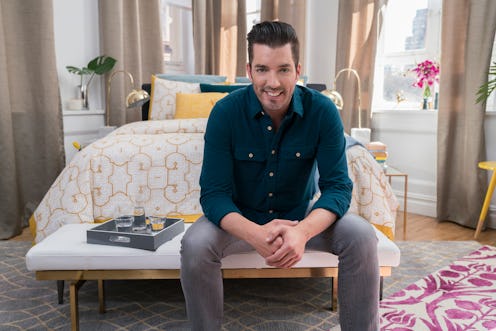Life
Jonathan Scott's 7 Tips For A Better Night's Sleep

As amazing as sleep is, for so many of us it can feel almost impossible to get a good night's rest. In honor of National Sleep Awareness week, Jonathan Scott, star of HGTV's Property Brothers, has some bedroom design advice to help you get a better night's sleep. Whether you have trouble falling asleep or staying asleep, the design of your bedroom and the atmosphere you create in your room can have a huge impact on the quality and amount of sleep you get. No matter what's going on in your life and keeping you from getting the rest you deserve, a few changes to the design of your bedroom can really improve how you sleep.
"The master bedroom is supposed to be a retreat that helps you wind down at the end of a stressful day and helps set you up right for the next day," Scott tells Bustle. From meetings and interviews to families and jobs, life can be stressful, and the last thing anyone wants to come home to is a bedroom cluttered with paperwork. The psychological influence of having a room that's organized and well-decorated is often overlooked. But, everything from the colors of your sheets to the flow of the room itself affects your mind and has a lasting impression on you throughout the day and night.
So, for anyone who's looking to invest in a great night's sleep and create the perfect sanctuary of relaxation, here are a few design tips courtesy of Property Brother Jonathan Scott.
1. Invest In a Quality Mattress
"It's not rocket science when it comes to the bedroom. Your bed is the most important piece," Scott explains. As the most used piece of furniture in the entire room, having a quality mattress makes all the difference in everyday life and in how we sleep. If you're looking for a mattress that is not only comfortable but able to support you throughout the seasons, Scott has recently designed his own Jonathan Scott special-edition mattress with Stearns & Foster.
2. Control Your Lighting
The lighting in a room sets the atmosphere for everything you do. "Have the lights on a dimmer so you can soften them in the evening ... and get smart lights," Scott says. "They can change color subtly — colors that can make you feel more relaxed in the evening, or colors that can wake you up and make you feel more refreshed in the morning." Curtains with black-out liners are also great for keeping out the heat in the spring and summer.
3. Get Rid of the Workspace
"A bedroom should be a place for relaxation... and maybe for fun, but the bedroom is not a place that should be chaotic," Scott says. Separating your workspace from your bedroom and keeping the room free of clutter can have a huge impact on your mentality. From kids' toys to paperwork, everything should be organized and stored away so as to create a clean space to return to and escape from the rest of your day.
4. Color Coordinate
This is where your creative side comes into play. "It's no secret that color evokes emotion, so when you're going into fall and winter, you want your space to feel warm and inviting and cozy," Scott says. The psychological and emotional impact of colors and textures in your room affects how you wind down and what state your mind is in before you fall asleep. Bright pops of color, for instance, such as oranges, yellows, greens, and fuchsia are particularly great for spring.
5. Swap Out Accent Pieces
Doing something as simple as swapping out lighter blankets for heavier throws in the winter, or replacing lighter accent pieces in the room with copper or brass pieces changes the look and feel of the entire room. Packing away different colored pieces and bringing them out each season can also save a lot of money when it comes to design. "A lot of people are worried it's going to cost them so much money to have to redo their bedroom every season, and it's not at all," Scott says. "It's subtle little things that go a long way in the bedroom."
6. Consider the Room Size
"There's no sense in having a big, bulky bench at the bottom of the bed or a big, bulky side table if it's just going to make the room feel even smaller," Scott says. Nothing good can come of having bulky furniture in a small room. The larger the furniture, the smaller the feel of the room and the more likely you are to feel trapped and uncomfortable. By incorporating less cumbersome pieces into the room, you can easily lessen the feeling of clutter in the room and create a more relaxing space.
7. Go With the Flow
"You want to try and look at the functional elements of the room when you're determining your furniture layout," Scott says. If you have to position your bed in front of a window, for instance, try getting a smaller headboard so as not to obstruct natural light from entering the room, he suggests. Whether it's making sure there's easy access to the master bathroom and closet doors, or keeping furniture from blocking light in the windows, the layout of a room should be functional and comfortable.
"I encourage people to look at stuff that I've done with Stearns & Foster, get inspired, don't be afraid of color, and just make sure that [the bedroom] is an area that evokes the keywords: cozy, comfortable, refreshing, and inspiring," Scott says. Now that you have a few tips to guide you in transitioning your room from winter to spring, a good night's sleep is only a comforter away.
Images: Courtesy of Stearns & Foster